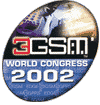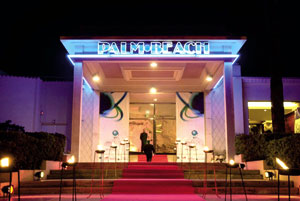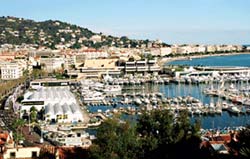
February 19-22, 2002,
Cannes, France
 |
World GSM Congress,
February 19-22, 2002, Cannes, France |

The World GSM Congress is one of the mobile industry's
most significant events. Every year in mid-February, people closely associated
with the GSM business worldwide gather in Cannes, the famous resort city
in France. Over the recent years the scale of the Congress has grown so
much that the auditorium in the famous hall of the Cannes film festival
can hold only a portion of those wishing to attend the forum. Because of
this adjacent buildings are also used for various Congress activities,
hotels, large and small, both in Cannes and in the neighbouring cities
are fully packed.
Such a keen interest in the Congress is only too natural
given the current changes and the fast development rate of the industry.
This year too the Congress was marked by its grand scale - the exhibition
area of up to 25,000 sq. meters accommodated the stands of 530 companies.
123 GSM operators function in fifty European countries.
The number of subscribers increased from 169 million to 281 million in
the year 2000, and reached 311 million in May 2001. As of February 2002,
620 million of the 840 million subscribers to mobile networks worldwide
use the GSM system. In China alone, 90 million people (about 75% of the
total number of mobile users in China) are GSM subscribers. The mobile
sector is now considered the world's most rapidly growing market.*
The Congress began with the three-day seminars dedicated
to the analysis of the ongoing developments and future prospects of the
industry. These seminars were intended for technical and marketing personnel.
Separate seminars were held for managerial staff.
The awards ceremony to honor the winners of this year's
GSM Association nominations, the central event of the Congress, took place
on the eve of the closing day of the Congress.
Best Technological Innovation:
The Best Mobile Phone - NTT DoCoMo (Japan) for FOMA 3G
phone
The Best Infrastructure and Network Solution - Wireless
Online (USA) for ClearBeam GSM/GPRS antenna
Best Service and Service Package:
The Best Customer Service - CodeOnline (Finland) for the
quiz “Who wants to win a million?”
The Best Customer Service Package - Network 365 (Ireland)
for its “mzone” product
Best Marketing Solution:
The Best TV Advertising - Sonera Corporation (Finland)
for its IN commercial
The Best Marketing Campaign - Orange (France) for its
brand advertisement
Contribution to Public Activities:
Developing a Special Program for the Handicapped - MTN
Network (Sri Lanka) for the project “Change”
Civic Contribution - Ericsson (Sweden) for swift and efficient
aid to the victims of natural disasters
Special Award of the GSM Association Chairman
The Chairman of the GSM Association annually names and
awards with a special prize an individual or organization for outstanding
achievements.

As expected, this year's prize was awarded to the Japanese
company NTT DoCoMo (as mentioned above, this company was also the winner
of the Best Mobile Phone nomination). DoCoMo is considered a pioneer among
mobile companies in the application of 3G technologies.
The i-mode service launched in 1999 by DoCoMo rapidly
gained popularity and already in December 2001 it was used by 30 million
subscribers. As a result of the introduction of the i-mode service, the
company's income from data transfer amounted to 20% of the company's total
income (by comparison, Vodafone Group, one of Europe's most successful
companies, is projected to achieve a similar distribution of income only
by 2004 or 2005).
Many experts were skeptical about the announcement made
at the 2001 Cannes Conference regarding the migration to 3G systems beginning
from May 2001. This skepticism was caused by what they thought was an unrealistic
date. NTT DoCoMo was only six months “late” making the world's first commercial
launch of the 3G service in November that same year. The WCDMA-based new
generation technology is in full compliance with the international standard
IMT-2000. The new system FOMA (Freedom Of Mobile Multimedia Access), developed
by the NTT DoCoMo Research Center jointly with Yokosula Research Park,
became the first new generation system combining the high-speed Internet,
video and music transmission and many other services.
The service is currently available only in Japan, but
it does not appear too remote for the rest of the world.
3G is the most expensive symbol in the mobile industry.
Major event of the Cannes Congress is the exhibition demonstrating
latest innovations in mobile technologies. It is here that the companies
involved in the industry announce their new accomplishments and where interested
people can see and get acquainted with the most recent developments in
the business.
* * *
* * *
Motorola remained the only manufacturer of GPRS phones for quite a long time. According to the announcement made at the Congress, the company intends to launch A820, a 3G model, by the third quarter of 2002. This will allow Motorola to be the first Western company to manufacture the 3G phones, remaining in the forefront of technological advancement.
* * *
At the Congress, Motorola announced its intention to work together with China Mobile on the research of the potential market for 3G in China and on selecting the best version of new generation networks for the country. According to the Chief of Motorola's Global Telecommunications Solutions Sector For the Chinese Market, “the development of the 3G technologies in China will greatly affect the development of telecommunications sector as well as the country's economy as a whole.”

* * *
Microsoft Corporation is playing an increasingly prominent
role in the mobile industry's software field. In 2001 the company announced
its decision to join the GSM Association. The Association has been joined
also by Cisco and Psion, and earlier by IBM and Bull, traditionally considered
IT sector companies. This trend once again emphasizes that the processes
of convergence of wireless and wire technologies are already drawing the
participation of the largest companies in the field. Last year showed that
Microsoft's success in the mobile industry is not as impressive as in the
software field. European companies, especially the major manufacturers
of mobile phones, prefer Symbian to Microsoft at this stage. The only exception
is SAMSUNG, which uses a Microsoft operational system.
Microsoft has not lost hope, however, and plans to increase
its influence by advancing SmartPhone to the PDA market. The alliance between
Microsoft and American Texas Instruments increases the chances of success
for such a phone.
* * *
SAMSUNG, in conjunction with Emblaze Systems, presented a video-phone for GPRS networks. The new terminal allows the viewing of musical clips, Internet and other animated pictures by means of the Emblaze Systems' ASIC chip. The image quality changes according to the band allocated by the network operator for GPRS networks, and may be regulated by adjusting the image size on the screen.
* * *
Levan Buchukuri
General Director
MagtiCom